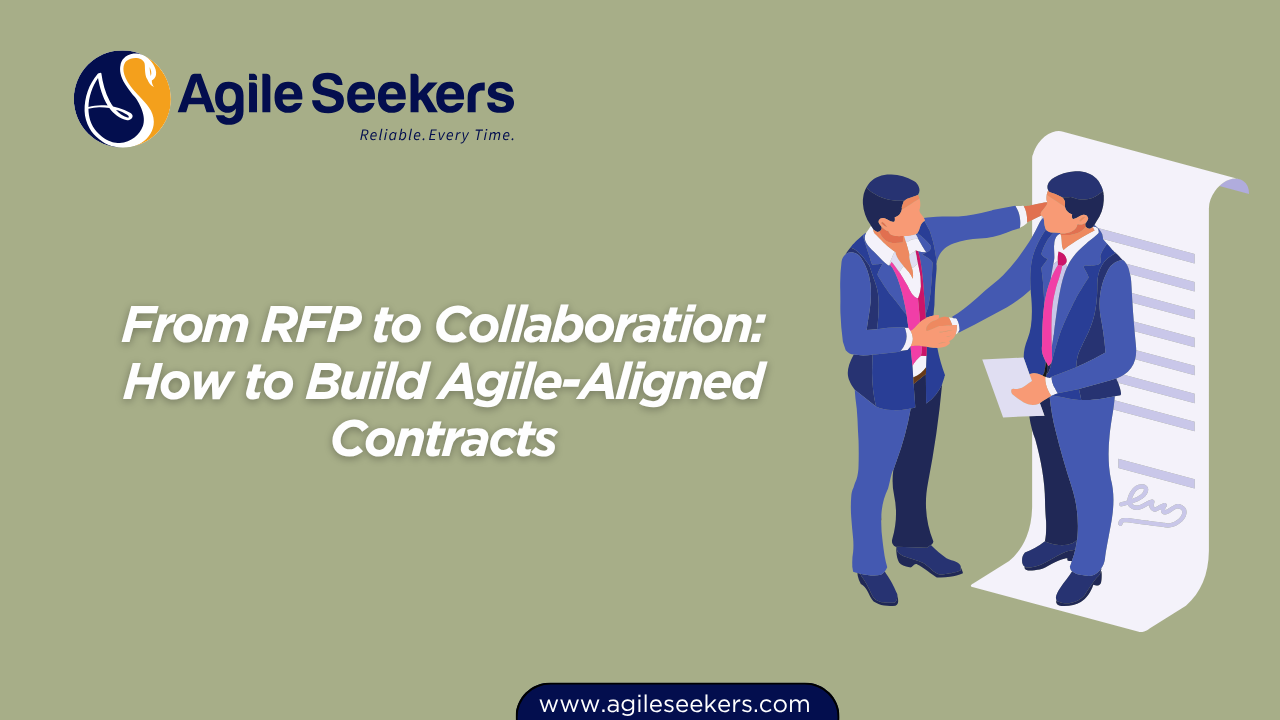From RFP to Collaboration: How to Build Agile-Aligned Contracts

Agile-aligned contracts require a fundamental shift from traditional procurement models. Instead of focusing solely on deliverables, timelines, and penalties, these contracts emphasize flexibility, shared understanding, and ongoing collaboration. This blog explores how to build Agile-aligned contracts from the initial Request for Proposal (RFP) stage to long-term collaborative execution.
1. Why Traditional RFPs Don’t Fit Agile Delivery
Most RFPs are designed for fixed-scope, fixed-price work. They typically lock in requirements too early, making it difficult to adapt to change later. Agile delivery thrives on evolving requirements, customer feedback, and iteration. A traditional RFP framework limits this flexibility and often sets up adversarial client-vendor relationships rather than partnerships.
A better approach is to use RFPs as a collaborative invitation rather than a rigid statement of work.
2. Designing Agile-Friendly RFPs
To align with Agile principles, the RFP should:
-
Focus on business outcomes, not just outputs
-
Encourage co-creation of scope and roadmap
-
Evaluate vendors based on collaborative capability, not just lowest cost
-
Request examples of working with Agile teams and product ownership
By doing this, procurement teams set the tone for agility right from the start.
3. Crafting the Right Evaluation Criteria
Agile contracts aren't just about code or deliverables—they're about how teams work together. Evaluation should include:
-
Vendor's experience with Agile frameworks like SAFe®
-
Ability to work with Product Owners and Product Managers
-
Past performance on incremental delivery
-
Understanding of Lean-Agile budgeting and flow-based metrics
Scoring vendors on their collaboration history helps ensure alignment with Agile delivery teams.
4. Choosing the Right Contract Model
Agile contracts typically favor one of the following models:
| Contract Model | When to Use It |
|---|---|
| Time & Materials (T&M) | When scope is uncertain and flexibility is needed |
| Capped T&M | Adds a budget cap to traditional T&M for risk control |
| Incremental Delivery | Payments tied to validated outcomes or increments |
| Managed Investment | Long-term funding tied to business value and learning |
The SAFe® Managed-Investment Contract is a prime example. It allows adjustments over time, funding initiatives based on value delivery rather than upfront scope.
5. Co-Creating Scope and Outcomes
Rather than locking scope upfront, Agile-aligned contracts encourage defining:
-
Vision and outcomes
-
High-level features or capabilities
-
Milestones based on value realization
-
Collaborative working agreements
This empowers roles like the SAFe Product Owner/Product Manager (POPM) to prioritize based on evolving insights.
Contracts should include mechanisms for regular alignment, such as PI Planning events, which are core to the SAFe Scrum Master role.
6. Defining Collaboration Cadences
Contracts must define how teams will collaborate. This includes:
-
Regular backlog refinement and reviews
-
Joint PI Planning sessions
-
Syncs between vendor delivery teams and Advanced Scrum Masters
-
Shared dashboards for progress and value metrics
A shared delivery cadence creates trust and transparency. Rather than managing the vendor by contract, teams manage through clear communication and feedback loops.
7. Governance Without Micromanagement
Agile governance focuses on enabling flow rather than controlling it. Instead of tracking every feature against a Gantt chart, contracts should track:
-
Velocity and throughput trends
-
Lean budgeting guardrails
-
Value delivered per increment
-
Feedback from system demos
These practices are supported by roles like the SAFe Release Train Engineer (RTE), who ensure smooth coordination across teams while maintaining visibility into delivery health.
8. Handling Change: Built-In Flexibility
Traditional contracts penalize change. Agile contracts should embrace it.
Key techniques include:
-
Rolling wave planning instead of detailed upfront estimation
-
Change budgets for emerging needs
-
Scope trade-offs within fixed timeboxes
-
Working agreements that allow for renegotiation based on validated learning
This mindset reduces friction and aligns the vendor-client relationship with product thinking.
9. Legal and Compliance Considerations
Agile contracts don’t mean ignoring compliance or legal structure. Instead:
-
Terms should protect IP rights, data security, and quality standards
-
Wording must clarify the collaborative nature of scope planning
-
Clauses should allow termination for non-performance, while encouraging co-learning and iteration
Legal teams increasingly recognize the value of outcome-based contracts and adaptive agreements. The shift toward lean-agile procurement is gaining traction across industries, including government agencies, where Agile RFPs are becoming more common.
10. From Contract to Continuous Collaboration
A signed contract should mark the beginning of a partnership—not a boundary. Teams should treat contracts as living artifacts that:
-
Support product evolution
-
Enable ongoing learning
-
Strengthen alignment across stakeholders
-
Remove friction between procurement, finance, delivery, and compliance
This collaborative approach is at the core of what frameworks like SAFe enable at scale.
Final Thoughts
Agile-aligned contracts move the conversation from control to co-creation. By shifting focus to outcomes, enabling continuous collaboration, and building flexibility into the structure, organizations can reduce delivery risk while maximizing value.
Procurement and legal teams that embrace this model don’t just buy deliverables—they invest in adaptive, value-driven partnerships. And with the right roles—Product Owners, Scrum Masters, and Release Train Engineers—aligned through the SAFe framework, they can make agility contractually real.
Also read - 7 Principles of Agile Contract Design Every Procurement Team Should Know
Also see - How to Structure a High-Performing Agile Release Train




















